Quaffing the local wine and stopping at medieval castles enroute
By Lucy Komisar
There‘s a bit of magic and fantasy in a day along the Mosel River, stopping at villages of half-timbered houses, trying wines from local vineyards, visiting centuries-old castles, and seeing stunning examples of a turn-of-the-last-century style called Art Nouveau.

We picked up the river route in Traben-Trarbach, between Trier (famous for Roman ruins) and Koblenz, arriving in the evening at the Jugendstilhotel Bellevue. Jugendstil means Modern Style as it was called in England, or Art Nouveau as the French named it. The hotel is not only charming and comfortable, but an architectural gem.
Art Nouveau developed as a rejection of turn-of-the-19th-to-20th-century upheaval and industrialization. Artists adopted shapes of nature; flowers with slim leaves and long-stalks were popular. Women were depicted with long flowing garments and hair. Elements of Modern Style are seen in the lithographs of Toulouse-Lautrec and in some Paris metro entrances.
We received a tour of the hotel and a briefing on the style from Adriane Zirker, an art historian. Why does the town have a hyphenated name, I wondered. She explained, “Traben-Trarbach used to be two towns on either side of the river. There was no bridge; people went by boat or a long way around. At the turn of the century, the towns became famous for wine, but the train station was on the Traben side. The other side wanted to be in the trade and decided to build a bridge, which was constructed by famous Art Nouveau architect Bruno Möhring, who thereby introduced his Modern Style to the burghers.
In 1903, Möhring designed the Bellevue, the town‘s first Modern Style building, set fashionably on the banks of the Mosel. His Art Nouveau mode included the traditional German “Fachwerk,” with half timber wood-beams on the facade. Wine merchants soon had their homes built to copy. Even the local train station was done in Art Nouveau.
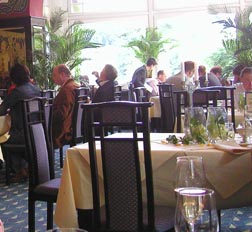
In the 19th century, the town was big, rich and famous. By the turn of the 1900s, it was the second largest wine trading town in Europe, and it is still surrounded by vineyards. Now it‘s a calm resort, popular with Germans and also with international visitors who have helped extend the season to year-around. Many come to the Bellevue for its two spas – the Indian “Panta rhei” and the traditional “Beauty Farm.” There is also a fitness room, pool and sauna. And you can rent a canoe to paddle on the Mosel or sit in the sun on a touring boat.
With dark wood furniture, blue patterned chairs and royal blue carpets, the Bellevue seems more like a private villa than a hotel. The new owner, Matthias Ganter, took over in 1992 and refurbished it. The dining room, with its stained glass windows, however, reminds one that this is a serious hotel, with an haute cuisine kitchen.
We sat at a table as candles in candelabra threw off soft light. We could see the river through the large windows. Chef Bernhard Tintemann that night was preparing rolled sole and Jacobs mussels, quail gelatine with goose liver, fish pastry with crayfish, bouillabaisse juice and keta-caviar croutons. For main courses, we had duck breast in port wine sauce and risotto of cress and white asparagus tips. And, of course, Mosel wine. This is not a Wienerschnitzel menu!
In the morning, after wandering along the river promenade, we set off north along the Mosel wine route. The first stop was a place on a jut of land west of Zell where we detoured to a café at the top of a hill to see the river in two places as it swirls around the mini-peninsula. I wanted to try the local wine. “Which of these is local?” I asked. One came from Zell, and the manager pointed to a town I could see across the river. The other came from Alf, and he indicated a village which I could make out just to the north. “Local” on the Mosel means around the corner or up the street! They were both excellent, fragrant, fresh.
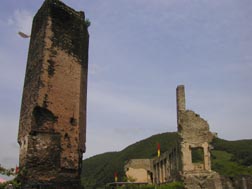
Following the river again, we crossed a bridge to Beilstein and Metternich‘s castle. This complex, largely in ruins, dates to 1268. It passed to the von Metternichs in 1637 and was owned at the end by the manipulative, warlike Austrian chancellor. The site was largely destroyed by the French in 1689, but there are enough walls and a tower to make an appealing place for a café at which we could have lunch and survey the surroundings.
Moving ahead north, we, alas, sped too fast through Cochem, an appealing town with its own castle. But we were headed for the Mosel‘s most visually arresting fortress, the Burg Eltz. It wasn‘t easy to find. On the first try, following some signs, we ended up at a tiny parking lot. Some people were returning to their car from a path in the woods. “Were you at the Burg Eltz? How long did it take to walk there?”
“Yes,” they said. “An hour!”
We decided there had to be another way!
By trial and error, we discovered the way is not, driving from the south, to turn off at the first signs to the castle, but to continue along the Mosel road to Hatzenport and Münstermaifeld, then to follow the directions to Burg Eltz. At the end, there‘s a parking place and a shuttle bus to the castle. We took the required 40-minute tour (no wandering around on your own), which is in German.
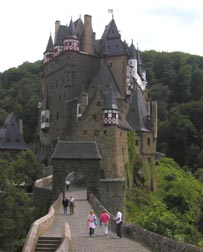
I was annoyed when, after paying $7.40 each for entrance, we had to pay 50 cents for a typed English summary of the tour! Such nickel-and-diming is tacky!
The Burg Eltz, however, is spectacular, especially from the outside. It is your fantasy imagination of what a castle should look like. It was started nearly a thousand years ago and continued to be added to through the 15th, 16th and 17th centuries in whatever was the contemporary style. It is owned now by Count Karl, of the Golden Lion branch of the family; the other branches are the Silver Lion and the Buffalo Horns. Sounds like the names of sports teams!
The palace, finished in 1472, is made of the several connected “houses” we saw on the tour. A living room has the original gigantic oak beams and fireplace, its walls now covered with 16th-century Flemish tapestries. A painting of the Virgin and Child in the lower hall is from the 16th century. A 15th-century painting of the Crucifixion includes a knight with the inscription “Elz” on his thigh. The Eltz family obtained the large clock 1500. We walked through the master bedroom, with painted ceilings and even an indoor toilet which was flushed through a sewage duct by rainwater collected from the roof.
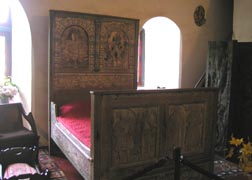
The largest room is the great hall, the family council room, with a fool‘s mask indicating that free speech is permitted to all inside! The rose, symbol of silence, carved in the lintel meant that nothing said in council could be repeated outside. There were also money chests and miniature cannons – models produced for prospective customers. Seems like all at Burg Eltz was politics and business as usual! From there, we went to a room that appeared to be a bedroom for children. It has a bed from 1525, the oldest Renaissance bed in Germany. Then to a space that has been used for banquets and has one of those wonderful old German stoves, this one a 19th-century copy of a 16th-century Nuremberg original.
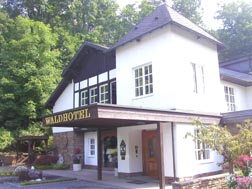
Leaving the fantasy castle, we set off to pick up the highway to Cologne enroute to another river, the Rhine, and another “Romantik” hotel on the outskirts of that city. The Waldhotel Mangold, just east of the Rhine in Bensberg, a section of Bergisch Gladbach, is set at the edge of a forest (Wald means woods) on green lawns with a small stream. The Mangold family has owned the building since 1925. It started as a restaurant; the owner‘s son turned it into a 22-room hotel in 1967. Now it‘s run by his sons, Hans and Jochem.
It seems more like an oversized villa than a hotel. Inside, there are wood-beamed ceilings, fireplaces, and nooks with overstuffed chairs. The breakfast room overlooks the gardens. When the hotel was a restaurant drawing families on the weekends, it adopted fairy-tale themes to appeal to children. Outside, among the shrubs, are statues of the Princess and the Frog and of Hansel, Gretel and the Witch. The family‘s oldest son is always Hans, after the boy in the story! From the Mosel to the Rhine, we found sweet doses of German fantasy!
Both the Bellevue and Waldhotel belong to Romantik Hotels & Restaurants International, an association started in 1972 that unites 181 family-owned and run hotels in 12 European countries. Member hotels must be places of history and tradition and offer charm, fine restaurants and wine cellars, warmth, hospitality and “Romantik flair.” They do, indeed!

Hotel Bellevue
Am Moselufer
D-56841 Traben-Trarbach
Tel 49 (0)6541 7030
Fax 49 (0)6541 703400
info@bellevue-hotel.de
Free wifi in rooms.
Hahn Airport 20 minutes drive; train stops in Traben.

Romantik Waldhotel Mangold
Am Milchbornbach 39-43
D-51429 Bergisch Gladbach
Tel 49 (0)2204 95550
Fax 49 (0)2204 955560
mangold@waldhotel.de
Hotel is 9 miles from Cologne, 20 minutes by bus and 10 minutes by car, and popular with people who attend the Cologne trade shows. It is 15 minutes from the Bonn/Cologne airport, and half an hour from Bonn and Dusseldorf.
Romantik Hotels & Restaurants International
info@romantikhotels.com
Burg Metternich
D-56814 Beilstein/Mosel
Tel 49 (0)2673 93639
Fax 49 (0)2673 936388
f.von.metternich@t-online.de

Burg Eltz
56294 Burg Eltz, Münstermaifeld
kastellanei@burg-eltz.de
Tel 49 (0)2672 950500
Fax 49 (0)2672 9505050
The best guidebooks:
Germany, Insight Guides, Langenscheidt Publishers.
This offers more detail about the history, art and economy as it moves through the towns and regions in a narrative style. Suggested hotels and restaurants. Good regional and local maps.
Germany, DK Eyewitness Travel Guides.
This takes you to each town and village and bullets key sites, with mini- on each page and the opening times, costs and other relevant information. Major museums and sites get diagrams, with more details about the key attractions. Suggested hotels and restaurants. Good regional and local maps.
Photos by Lucy Komisar.

